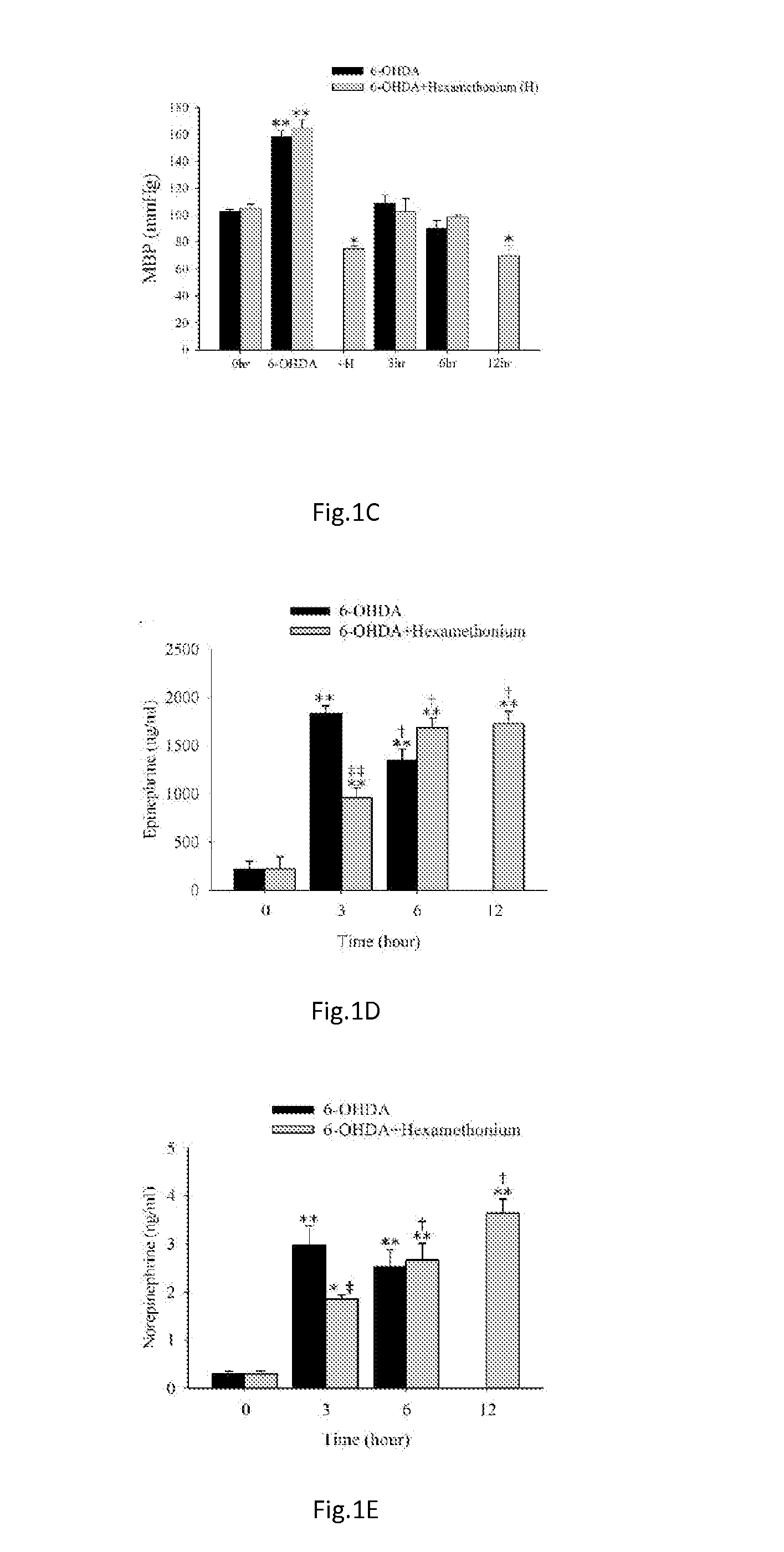Hexamethonium Reverses the Lethal Cardiopulmonary Damages in a Rat Model of Brain Stem Lesions Mimicking Fatal Enterovirus 71 Encephalitis
- Summary
- Abstract
- Description
- Claims
- Application Information
AI Technical Summary
Benefits of technology
Problems solved by technology
Method used
Image
Examples
example 1
[0047]Referring to FIGS. 1A to 1E, a nature history and the changes of catecholamines in hexamethonium treatment vs. placebo were shown. As shown in FIG. 1A, acute hypertension was produced after the rat was administered with 6-OHDA lesions and the rat died suddenly within 7 hours (n=6). As shown in FIG. 1B, the acute hypertension was reversed after hexamethonium administration. All rats survived for at least 14 hours (n=6). As shown in FIG. 1C, a significant acute high rise in mean blood pressure (MBP) caused by 6-OHDA lesions was significantly reversed with hexamethonium treatment (vs. respective 0 hr, n=6 per group). In FIGS. 1D and 1E, similarly, the acute high rise of epinephrine and norepinephrine serum levels post 6-OHDA lesions was significantly lowered within 3 hours after hexamethonium treatment (n=6 per group). Data represent means±S.E.M.*, P**, P<0.001 vs. respective 0 hr. +, P<0.001 vs. respective 3 hr. ‡, P<0.05 and ‡‡, P<0.001 6-OHDA vs. 6-OHDA+Hexamethonium.
[0048]In ...
example 2
[0051]In cardiac morphology, we found that there were no significant changes in the gross specimens of heart (FIG. 2A), but the LV wall thickness increased at 3 hours and 6 hours after 6-OHDA lesion in the cross-section of the heart (FIG. 2B). From echocardiographic 2-dimensional short-axis views (FIG. 2C) and M-model images (FIG. 2D), it was revealed that acutely decrease cardiac output at 3 hours and 6 hours after 6-OHDA lesions were prevented with hexamethonium treatment (FIG. 2E). The acute increase in ejection fraction (FIG. 2F), fraction shortening, and LV wall thickness (FIGS. 2G and 2H) were attenuated or reversed at 3 hours with hexamethonium treatment. In addition, the decrease in the LV internal dimension in diastole and systole were reversed or attenuated at 3 hours and 6 hours with hexamethonium treatment. Data represent means±S.E.M.*, P<0.05 and **, P<0.001 vs. representative 0 hr. +, P<0.05 vs. representative group 3 hr. ‡, P<0.05 vs. representative group 6 hr. §, P<0...
example 3
[0052]Referring to FIGS. 3A to 3G, pathological changes on hearts specimens in hexamethonium treatment (+H) vs. placebo (original magnificent 400×; inset original magnificent 100×) were shown. FIG. 3A was regarded with representative examples of the hematoxylin and eosin stain. As shown in FIG. 3A, the increase of the irregular wavy fibers with increased eosinophilic staining of the cytoplasm (indicated by the arrowhead) and contraction bands necrosis (indicated by the concave arrowhead) at 3 hours and 6 hours in the 6-OHDA group was prevented by hexamethonium treatment (n=6 per group). FIGS. 3B and 3E showed the representative examples of cardiac troponin T (original magnification 280×). Myocardial section co-stained with antibodies directed against troponin T antibody (green) and nuclei were stained by DAPI (blue). The increased expression of troponin Tat 6 hours in the 6-OHDA group was reduced by hexamethonium treatment (n=4 per group). FIG. 3C showed representative examples of b...
PUM
| Property | Measurement | Unit |
|---|---|---|
| Time | aaaaa | aaaaa |
| Dimensionless property | aaaaa | aaaaa |
| Dimensionless property | aaaaa | aaaaa |
Abstract
Description
Claims
Application Information
 Login to View More
Login to View More - R&D
- Intellectual Property
- Life Sciences
- Materials
- Tech Scout
- Unparalleled Data Quality
- Higher Quality Content
- 60% Fewer Hallucinations
Browse by: Latest US Patents, China's latest patents, Technical Efficacy Thesaurus, Application Domain, Technology Topic, Popular Technical Reports.
© 2025 PatSnap. All rights reserved.Legal|Privacy policy|Modern Slavery Act Transparency Statement|Sitemap|About US| Contact US: help@patsnap.com



